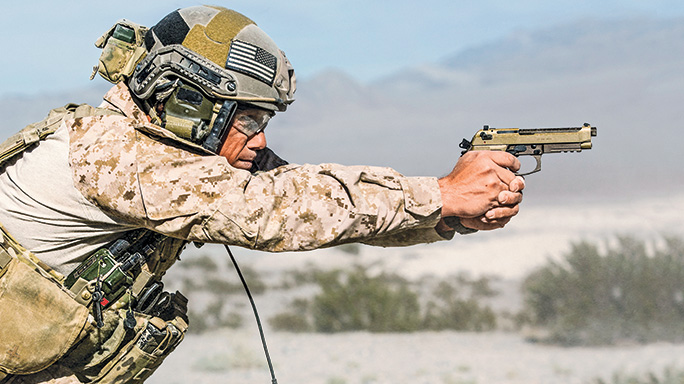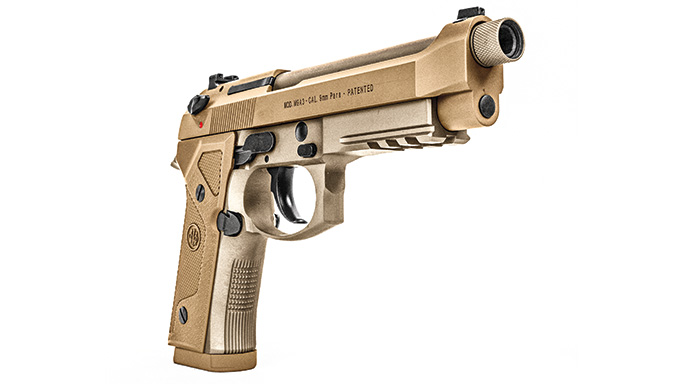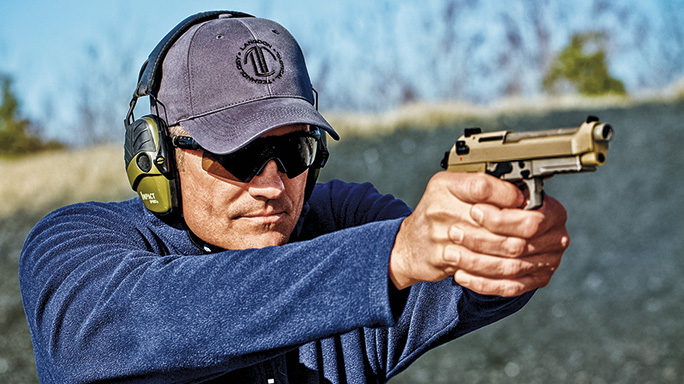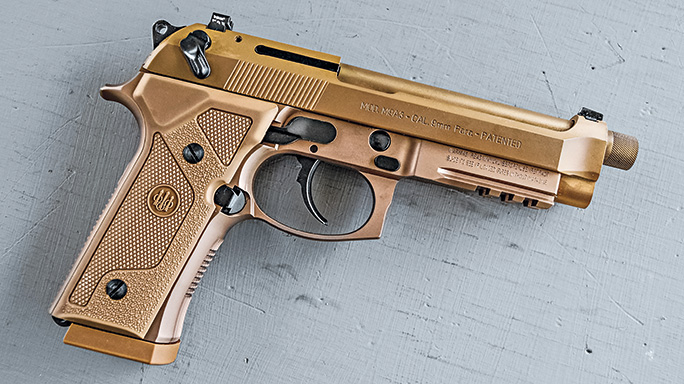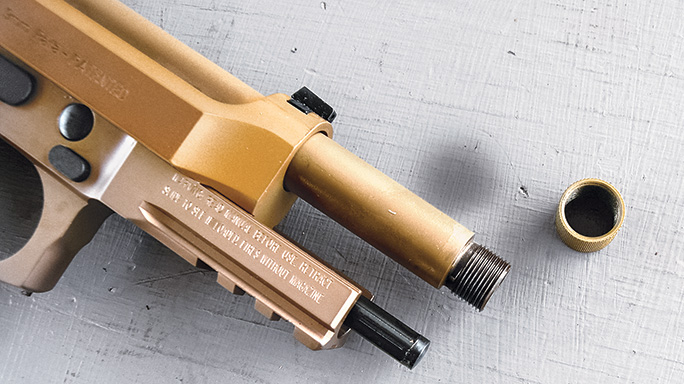The M9 service handgun, the U.S. military’s version of the 9mm Beretta 92FS, has been in continuous service with the military since 1985.
For several years there has been plenty of programmed concern in picking its replacement. Over a decade ago was the Future Handgun System (FHS), which merged with the U.S. Special Operations Command (USSOCOM) Joint Combat Pistol (JCP) program. The idea was to quickly and inexpensively pick a suitable, off-the-shelf M9 replacement. Several years and millions of dollars later yielded no change.
Advertisement — Continue Reading Below
The Army and Air Force, with input from a Marine Corps committee, then decided to collaborate on a similar project, creating the Modular Handgun System (MHS) program. The MHS also sought to select an already-available commercial replacement and released a Request For Information calling for a pistol with 2,000 mean rounds between stoppages (MRBS), 10,000 mean rounds between failures and a 35,000-round service life. The M9 has passed five consecutive LATs (Lot Acceptance Tests) with an average MRBS of 25,000—that is 10 times the MHS requirement!
The House Armed Services Committee pushed to cancel the MHS and upgrade the M9 instead as a less expensive option capitalizing on existing components and know-how. But even a project created to evaluate existing designs featured a three-year engineering, manufacturing, and development phase. In an attempt to appease the MHS specifications while meeting the House’s suggestions, Beretta created its M9A3 pistol upgrade, which takes into account Engineering Change Proposals (ECPs) under the existing contract while providing what is likely the most cost-effective solution.
Shortly after, reports circulated that the Army had rejected the Beretta M9A3, seemingly out of hand. The House of Representatives released H.R.1735 in May 2015. Concerning the Modular Handgun System, the House budget contained $5.4 million to procure 7,106 MHS-approved pistols. The House committee encouraged modernizing the current inventory of small arms through new procurement and product improvement programs. While it supports the MHS, the House, “remains concerned over the continued delay in releasing the official request for proposals (RFPs).” Army Contracting Command has since released an official MHS RFP in August 2015, listing a program value of up to $580 million.
Advertisement — Continue Reading Below
M9 Evolution
The Beretta 92 was designed in the early 1970s, evolving from several older models. The company’s M1922 featured an open slide, and the M1951 used an alloy frame and articulating locking block instead of a Browning-style tipping barrel. The .380 ACP Model 84 featured a double-stack magazine similar to the Browning Hi-Power and a direct, in-line feeding system that eliminated the need for a feed ramp. The Beretta 92’s initial production run lasted from 1976 to 1983 with 52,000 total units.
During this time, the Department of Defense was maintaining a rapidly aging inventory of over two-dozen models of pistols and revolvers. A 1982 comptroller general’s report listed 417,448 Model 1911s in .45 ACP in inventory and suggested converting the existing 1911 pistols to fire the NATO-standard 9mm cartridge as a less expensive alternative to adopting a new weapon. Instead, the Army ordered a formal request for test samples to arms makers. Eight makers submitted 30 test pistols. Four makes were deemed technically unacceptable, and two others removed themselves from the competition, leaving the Sig Sauer P226 and Beretta 92. Both met the test specifications, but Beretta won the bid on price, earning a contract for 321,260 of the newly dubbed M9 pistols.
Advertisement — Continue Reading Below
As with nearly every weapon ever mass-fielded in any military, the M9 had some growing pains. Army tests revealed a slide failure in testing three pistols after 23,300 rounds in one, and over 30,000 rounds in the other two. An examination of the broken slides showed that the metal was weak. Beretta voiced concerns that both non-NATO and U.S. M882 ball rounds were loaded to higher pressures than NATO specifications, though Army testing held that the problem involved the metallurgy of the newly issued slides. In addition to fixing the metallurgical issues, Beretta modified contract M9s with an enlarged hammer pin mated to a groove in the slide to stop it in case of catastrophic failure. This modification became known as the 92FS model.
Decades later, reports from the Middle East surfaced concerning the M9’s reliability with certain magazines. In the intervening years, alternative vendors had been supplying M9 magazines instead of the original Beretta and Mec-Gar units. Wartime experience in desert regions revealed that these “other” magazines were less durable and more sensitive to sand. The fix was to use the reliable, original-spec Beretta and Mec-Gar magazines.
Advertisement — Continue Reading Below
Finally, shooters have noted that the M9’s Achilles’ heel can be the locking block, though civilian 92FS and Elite models don’t seem to have suffered this. Beretta lists the average durability of M9 locking blocks at 22,000 rounds. Broken locking blocks are a potential problem with older-generation parts and can be exacerbated if the recoil spring isn’t replaced when needed or if the block doesn’t mate evenly with the slide. Beretta has addressed this with its current-generation locking block and locking block plunger.
Meet The Beretta M9A3
Military Service Conditions matches throughout NATO nations find American personnel frequently winning with issued M9s. Ben Stoeger, a police officer turned professional shooter, won his first series of USPSA Production Nationals and other numerous championships using the Beretta 92 series. The same goes for Ernest Langdon and his IDPA and USPSA national, area and state championships. While striker-fired pistols are well represented in Production and Stock competition divisions, DA/SA designs remain a preference for many competitors.
Advertisement — Continue Reading Below
The M9A3 is Beretta’s material and design upgrade of the M9. The first obvious difference is its Flat Dark Earth coloring. More than just looks, the pistol has a combination of Cerakote, anodizing, Bruniton, black oxide and PVD finishes to improve lubricity as well as corrosion and wear resistance. At the front of the M9A3’s frame is an integral, three-slot Picatinny rail for accessory lights and lasers. The chrome-lined barrel is extended and threaded for suppressors. Both the front and rear sights are dovetailed for adjustments or removal, and tritium night sights come standard from the factory. The factory magazine release is enlarged, and the frame has a generous bevel in the magazine well for quicker reloads. As to the magazines themselves, they have been improved to be sand resistant with an increased capacity of 17 rounds.
The Beretta M9A3 features a thinner, Vertec-style grip that improves pointability for some and reduces the “blocky” feel common with double-stack pistols, and making it easier to reach the trigger for shooters with smaller hands. The wraparound grip can be used to improve purchase for those with larger hands. The front- and backstraps are checkered.
Internally, Beretta used its next-gen locking block, which has been proven to improve the pistol’s service life. The Beretta M9A3 slide can be converted from “FS” to “G” mode, changing the safety/decocker into decocker-only operation. The levers are off-center to minimize accidental activation of the safety lever when racking the slide.
Advertisement — Continue Reading Below
On The Range
The Beretta M9A3 is the best-shooting factory service pistol I’ve used to date. With the obvious exception of match-prepared bullseye guns, it is also the most accurate. Starting with groups fired from a rest, I had no trouble shooting five-round groups at 25 yards into 2 inches or less with various loads. Between the nice DA/SA trigger and Trijicon sights, it was easy to get hits in the 10 ring at 25 yards from a standing, unsupported position. The ported magazine well and enhanced controls give the M9A3 the handling characteristics found in good practical competition pistols.
Going with the Beretta M9A3 maintains compatibility with existing armorer support, parts, magazines and ammunition, and it doesn’t require a new vendor or contract and concomitant developmental issues. There is no need for new equipment training, as all operator maintenance and manual of arms remains consistent. Current-issue M9s can still be used and slowly brought back from frontline service to reserve and garrison training environments and used even as new M9A3s are fielded. And the M9A3 meets or exceeds all desired specifications and performs at least as well as any viable alternative. Perhaps such an obvious, effective and cost-efficient solution is just lost on the personnel staffing procurement committees.
Advertisement — Continue Reading Below
For more on the Beretta M9A3, visit beretta.com.
Beretta M9A3 Specifications
- CALIBER: 9mm
- BARREL: 4.9 inches
- OA LENGTH: 8.5 inches
- WEIGHT: 33.9 ounces (empty)
- GRIPS: Polymer
- SIGHTS: Tritium three-dot
- ACTION: DA/SA
- FINISH: Flat Dark Earth Cerakote
- CAPACITY: 17+1
- MSRP: $1,099
